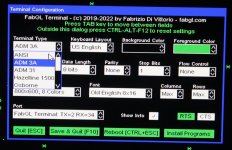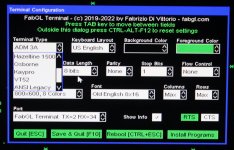any of the devices that use the FABGL library have a set list of terminals its all built into the library you can also add to the existing.
Any device that is using an ESP32 and loaded with the Fabgl will have the same specs.
its buried in a mountain of source code
but:
ANSI_VT, /**< Native ANSI/VT terminal */
ADM3A, /**< Emulated Lear Siegler ADM-3A terminal */
ADM31, /**< Emulated Lear Siegler ADM-31 terminal */
Hazeltine1500, /**< Emulated Hazeltine 1500 terminal */
Osborne, /**< Emulated Osborne I */
Kaypro, /**< Emulated Kaypro */
VT52, /**< Emulated VT52 terminal */
ANSILegacy /**< Legacy ANSI emulation */
FABGL offers additional graphics and sound support through escape codes which overlay any of the existing terminals.
There have been some TEK porting however there are existing TEK emulated terminals that are much better.
so you can be in Kaypro mode and using additional escape codes create music and high res graphics up to 64 colors.
its just remapping the terminal escape codes through the FABGL library to produce the expected outcome.
any time you see a terminal that is using some form of ESP32 it is most likely loaded with FABGL and you have access to everything it offers.
you also get additional remapping of keys supported. for Wordstar for example the cursor keys now work as they are automatically remapped for wordstar escape codes.
you also have ANSI Color text support in pretty much all terminal modes.
it would be possible to define POCKETERM as another terminal FABGL supports. its just remapping escape codes through the library.
you also have full mouse support through escape codes. allowing you to create your own GUI if you wish.
ESP32 has enough power to emulate full systems as well.
shows you all the currently official things it can do with ANSI Terminal just being one of them.
it is extremely powerful as a stand alone terminal. of course there are virtual equivalents running under windows,linux,macos etc.
its different when you have some old VGA monitor and PS/2 mouse and keyboard as a terminal to type on verse a terminal window on a modern machine.




